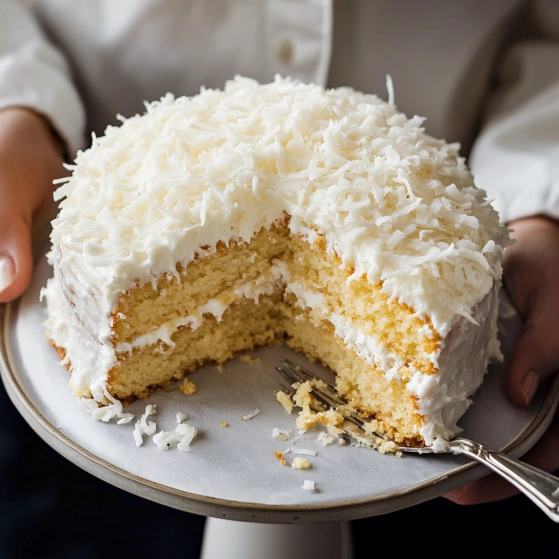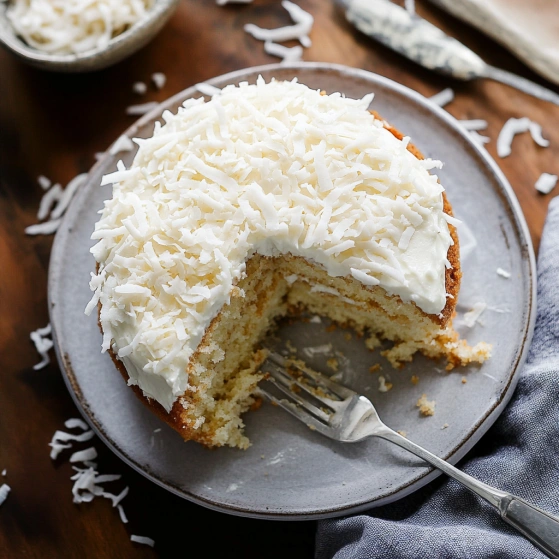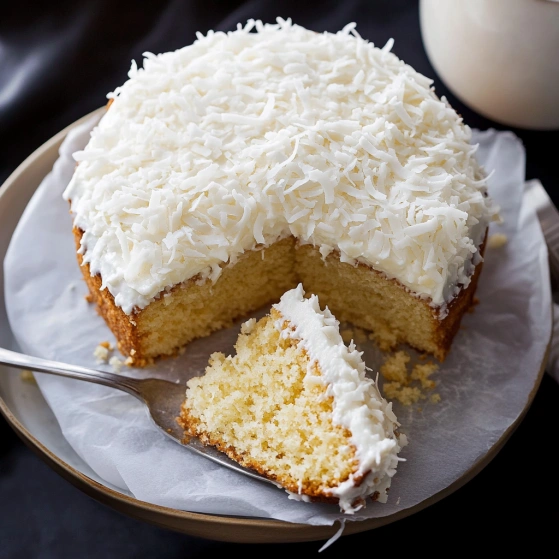 Pin it
Pin it
This tender single layer coconut cake delivers pure tropical flavor in every bite. The rich coconut buttercream frosting topped with toasted coconut flakes creates the perfect balance of sweetness and texture for an indulgent dessert that feels both special and approachable.
I first created this cake for my mother's birthday since coconut is her absolute favorite flavor. The look on her face when she tasted that first bite convinced me this recipe needed to become part of our family's regular dessert rotation.
Ingredients
- Cake flour: creates a more delicate crumb than all purpose flour for that perfect light texture
- Coconut milk: the secret to infusing deep coconut flavor throughout the cake batter
- Coconut extract: enhances the tropical taste profile without being overwhelming
- Toasted coconut flakes: add wonderful texture and a nutty dimension to both cake and frosting
- Egg white: whipped separately then folded in creates exceptional lightness in the final cake
- Coconut oil: contributes additional coconut flavor while keeping the cake moist for days
Step-by-Step Instructions
- Prepare the pan:
- Generously coat a 6 inch round cake pan with flour based baking spray ensuring every corner is covered. This step is crucial for clean release once baked. Preheat your oven to 350°F to ensure it reaches the proper temperature before the batter goes in.
- Toast the coconut:
- Cook sweetened coconut flakes in a dry skillet over medium heat stirring constantly until they turn a beautiful golden brown about 3 4 minutes. Watch very carefully as coconut can burn quickly. The toasting process releases natural oils and enhances the flavor tremendously.
- Mix dry ingredients:
- Whisk together cake flour baking powder baking soda and salt in a medium bowl until thoroughly combined. This even distribution ensures the cake rises uniformly and has consistent texture throughout.
- Whip egg white:
- Beat the egg white and cream of tartar at high speed until stiff glossy peaks form usually 2 3 minutes. The cream of tartar stabilizes the egg white allowing it to hold air better which gives the cake exceptional lightness.
- Cream butter and sugar:
- Beat butter coconut oil and sugar together until light and fluffy about 3 minutes. This incorporates air into the batter and helps create a tender crumb. Scrape down the bowl periodically to ensure even mixing.
- Add wet ingredients:
- Incorporate egg yolk coconut extract vanilla extract and coconut milk mixing until just combined. These liquid ingredients provide moisture and flavor to the cake while the extracts intensify the coconut essence.
- Combine batters:
- Gently fold in the dry ingredient mixture until just incorporated then carefully fold in the whipped egg white and toasted coconut. The folding technique preserves the air bubbles for maximum rise and tenderness.
- Bake to perfection:
- Pour batter into the prepared pan and bake for 30 35 minutes until a toothpick inserted in the center comes out clean. The cake should spring back lightly when touched and pull away slightly from the sides of the pan.
 Pin it
Pin it
The toasted coconut is truly what elevates this cake from good to extraordinary. I discovered this trick from my grandmother who always insisted on taking the extra few minutes to toast the coconut flakes before adding them to any recipe. The difference in depth of flavor is remarkable.
Make Ahead Options
This coconut cake actually improves with a little time. You can bake the cake layer up to two days before serving just wrap it tightly in plastic wrap once completely cooled. The buttercream can be made one day ahead stored in an airtight container in the refrigerator. Let it come to room temperature and re whip before frosting your cake for the smoothest application.
Storage Guidelines
Keep this frosted cake at room temperature in an airtight container for up to 3 days. The high fat content in the coconut and buttercream helps maintain moisture. For longer storage refrigerate for up to 5 days but allow cake to come to room temperature before serving for best flavor and texture.
Perfect Pairings
Serve this coconut cake with a scoop of vanilla ice cream or alongside fresh tropical fruits like mango or pineapple. For beverages a cup of hot coffee provides wonderful contrast to the sweet coconut flavors. For special occasions pair with a glass of dessert wine like Moscato or coconut rum for an adults only treat.
 Pin it
Pin it
Frequently Asked Questions
- → Can I use coconut flour instead of cake flour?
Coconut flour is not recommended as a direct substitute for cake flour in this recipe. Coconut flour absorbs significantly more moisture and would drastically change the cake's texture. Instead, if you don't have cake flour, you can make your own by replacing 2 tablespoons of all-purpose flour with 2 tablespoons of cornstarch for each cup needed.
- → How do I properly toast coconut flakes?
To toast coconut flakes, place them in a dry skillet over medium heat and stir continuously until they turn a light golden brown color. Watch them carefully as coconut can burn quickly. Alternatively, you can spread them on a baking sheet and toast in a 325°F oven for 5-10 minutes, stirring occasionally until golden.
- → Can I make this cake a day ahead?
Yes, this cake can be made a day ahead. Once completely cooled, wrap it tightly in plastic wrap if unfrosted, or store in an airtight container if frosted. Keep at room temperature if serving within 24 hours, or refrigerate for up to 3 days. Let come to room temperature before serving for the best flavor and texture.
- → What can I substitute for coconut extract?
If you don't have coconut extract, you can use vanilla extract as a replacement, though the coconut flavor will be less pronounced. Another option is to use 1-2 teaspoons of coconut rum, which will add both flavor and aroma. For a non-alcoholic alternative, you could steep toasted coconut in warm milk before cooling and using in the recipe.
- → How do I know when my egg whites have reached stiff peaks?
Egg whites have reached stiff peaks when you can lift the beaters out and the peaks stand straight up without folding over at the tips. The mixture will be glossy and hold its shape firmly. You can test this by turning the bowl upside down - properly beaten stiff peaks should not slide or move.
- → Can I turn this into cupcakes instead of a cake?
Yes, this recipe can be converted to cupcakes. Line a muffin tin with paper liners and fill each about 2/3 full. Bake at the same temperature (350°F) but reduce the baking time to approximately 18-22 minutes. This recipe should yield about 6-8 cupcakes depending on their size.
